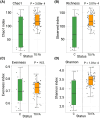Impact of oral immunotherapy on diversity of gut microbiota in food-allergic children
- PMID: 40747641
- PMCID: PMC12314854
- DOI: 10.1111/pai.70156
Impact of oral immunotherapy on diversity of gut microbiota in food-allergic children
Abstract
Background: Food allergies (FAs) are an increasing public health concern, particularly in children. Oral immunotherapy (OIT) is an emerging treatment strategy under clinical investigation for desensitization of children with FA to food allergens. Dysbiosis of the gut microbiota has been implicated in FAs, and various factors influence its composition; however, the impact of OIT on the gut microbiota remains largely unexplored.
Objective: This study aimed to identify the changes in diversity of the gut microbiota following OIT in children with FA.
Methods: Thirty children with FA (mean age 3.93 years, age range 2.00-14.00) undergoing oral immunotherapy targeting legumes (lentils, peanuts, peas), tree nuts (cashews, hazelnuts, pistachios), animal products (milk, egg), and fish and shellfish (salmon, shrimp), as well as seven non-allergic controls (mean age 2.65 years, age range 0.25-5.00) participated in this study. Fecal samples were collected before and after OIT from children with FA, and once from controls. The gut microbiota was profiled using 16S rRNA sequencing, followed by diversity and differential abundance analyses. Alpha and beta diversities were compared, and differential abundance was assessed.
Results: Beta diversity analysis revealed small but significant differences in microbial composition between children with FA before and after OIT, and between controls and children with FA before OIT. Differential abundance analysis showed that OIT induced a reversion of the abundance levels of Bacteroidota and Verrucomicrobiota toward those observed in controls.
Conclusion: To our knowledge, this is the first study to investigate the impact of OIT on the gut microbiota in children with different FAs for identifying potential microbial biomarkers and convincingly demonstrated their interrelation. These findings may help improve and personalize FA treatment.
Keywords: bacteroidota; children; food allergy; gut microbiota; oral immunotherapy; verrucomicrobiota.
© 2025 The Author(s). Pediatric Allergy and Immunology published by European Academy of Allergy and Clinical Immunology and John Wiley & Sons Ltd.
Conflict of interest statement
The authors declare no conflict of interest in relation to this study.
Figures





References
-
- Seth D, Poowutikul P, Pansare M, Kamat D. Food allergy: a review. Pediatr Ann. 2020;49:e50‐e58. - PubMed
-
- Cosme‐Blanco W, Arroyo‐Flores E, Ale H. Food Allergies. Pediatr Rev. 2020;41:403‐415. - PubMed
-
- Cheng Y, Liu X, Chen F, et al. The roles and mechanisms of gut microbiota in food allergy. Adv Gut Microb Res. 2023;2023:1‐16.
-
- Kazmi W, Berin MC. Oral tolerance and oral immunotherapy for food allergy: evidence for common mechanisms? Cell Immunol. 2023;383:104650. - PubMed
MeSH terms
Substances
Grants and funding
LinkOut - more resources
Full Text Sources
Medical
Research Materials
Miscellaneous

